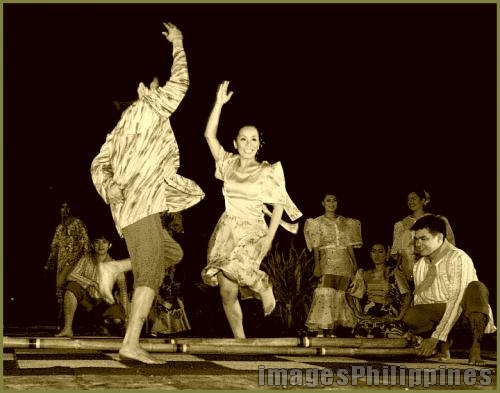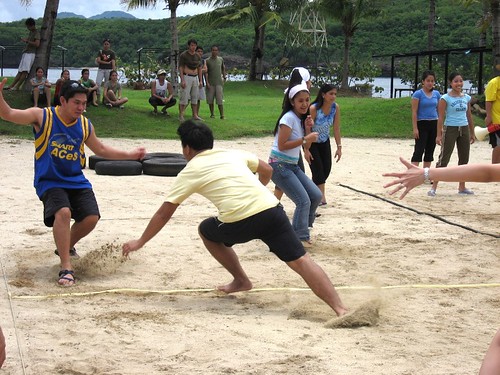About two-fifths of the
Religion in the
The
Arts of the Philippines
Literature
The literature of the Philippines illustrates the Prehistory and European colonial legacy of the Philippines Philippines
Performing Arts
Music
Spanish settlers and Filipinos played a variety of musical instruments, including flutes, guitar, ukelele, violin, trumpets and drums. They performed songs and dances to celebrate festive occasions
Fiesta
Dance
Philippine folk dances include the Tinikling and Carinosa. In the southern region of

Tinikling

Singkil Princess
Cuisine
Eating out is favorite Filipino pastime. A typical Pinoy diet consists at most of six meals a day; breakfast, snacks, lunch, snacks, dinner and again a midnight snack before going to sleep. Rice is a staple in filipino diet, it is usually eaten together with other dishes. Filipinos regularly use spoons together with forks and knives. Some also eat with their hands, especially in informal settings, and when eating seafood. Rice, corn, and popular dishes such as adobo (a meat stew made from either pork or chicken), lumpia (meat or vegetable rolls), pancit (noodle dish) and lechon(roasted pig) are served on plates.

Lechon
Other popular dishes include: afritada, asado, chorizo, empanadas, mani (roasted peanuts), paksiw (fish or pork, cooked in vinegar and water with some spices like garlic and pepper),pan de sal (bread rolls), pescado (fried or grilled fish), sisig, torta (omelette), kare-kare (ox-tail stew), kilawen, pinakbet (vegetable stew), pinapaitan, and sinigang (tamarind soup with a variety of pork, fish or prawns). Some delicacies eaten by some Filipinos but may seem unappetizing to the Western palate include balut (boiled egg with a fertilized duckling inside), longanisa (sweet sausage) and dinuguan (soup made from animal blood).

Balut
Popular snacks and desserts such as chicharon (deep fried pork or chicken skin), halo-halo(crushed ice with evaporated milk, flan, and sliced tropical fruits), puto (white rice cakes), bibingka (rice cake with butter or margarine and salted eggs), ensaymada (sweet roll with grated cheese on top), polvoron (powder candy) and tsokolate (chocolate) are usually eaten outside the three main meals. Popular Philippine beverages include San Miguel Beer, Tanduay Rhum Masters, lambanog and tuba.
Patis, suka, toyo, bagoong and banana catsup are the most common condiments found in Filipino homes and restaurants.
Sports in the Philippines
basketball, boxing, billiards, chess, ten-[in bowling, volleyball, horse racing and cock fighting. Doge ball and badminton are also popular.
Traditional Filipino games
Traditional Filipino games include yo-yo, piko, patintero, bahay kubo, pusoy and sungka. Pusoy is a popular gambling game. Individuals play the game by trying to get rid of all the cards by choosing poker hands wisely. Sungka is played on a board game using small sea shells in which players try to take all shells. The winner is determined by who has the most shells at the point when all small pits become empty.

Filipinos playing Patintero
One aspect of agriculture is "Fisheries"
The Freshwater Fishponds
There are 14,531 ha freshwater fishponds in the Philippines but the productive area is only 6,522 ha as of 1995 (BFAR, 1997). In 1987 when the total area was only 13,806 ha, 149 ha of this was listed as government owned (BFAR, 1987). Even with the slight increase in the total hectarage, the government-owned area, most likely, would not have changed much. Thus about 99% can be considered privately owned. The freshwater fishponds are concentrated in only one region of the country. Some 68% of the productive area, or 4,427 ha are found in Central Luzon. The rest, or 34%, are distributed in the 12 other regions, with no region having a total area reaching 1,000 ha.
In a 1979 survey covering 396 fishponds in Central Luzon, Reyes et al (1982) found that 70% were 0.50 ha or less while only 2% were over 50 ha. However this percentage is misleading since the average area of the 2 percent over 50 ha are 200 ha. Consequently when the percentages of each size class are computed by area, it turns out that 2% of the fishponds occupy 68% of the total area in the survey sample as shown in Figure 5. Although the study was conducted 16 years ago, the size distribution is not likely to have changed much. Fishponds are exempt from land reform as will be discussed at length in a later section.
 Fisher man
Fisher man
Main aspect of agricultre is Palay farming
Rice production in the Philippines is important to the food supply in the country and economy.
Rice is the most important food crop, a staple food in most of the country. It is produced extensively in Luzon, the Western Visayas, Southern Mindanao, and Central Mindanao. In 1989 nearly 9.5 billion tons of palay were produced.[1] In 1990 palay accounted for 27 percent of value added in agriculture and 3.5 percent of GNP. Per hectare yields have generally been low in comparison with other Asian countries. Since the mid-1960s, however, yields have increased substantially as a result of the cultivation of high-yielding varieties developed in the mid-1960s at the International Rice Research Institute located in the Philippines. The proportion of "miracle" rice in total output rose from zero in 1965-66 to 81 percent in 1981-82. Average productivity increased to 2.3 tons per hectare (2.8 tons on irrigated farms) by 1983. By the late 1970s, the country had changed from a net importer to a net exporter of rice, albeit on a small scale.
This "green revolution" was accompanied by an expanded use of chemical inputs. Total fertilizer consumption rose from 668 tons in 1976 to 1,222 tons in 1988, an increase of more than 80 percent. To stimulate productivity, the government also undertook a major expansion of the nation's irrigation system. The area under irrigation grew from under 500,000 hectares in the mid-1960s to 1.5 million hectares in 1988, almost half of the potentially irrigable land.
Palay Field
Overseas Filipino Worker's dollar remittances keep our economy afloat during the latest economic crisis
An Overseas Filipino is a person of Philippine origin who lives outside of the Philippines. This term applies both to people of Filipino ancestry who are citizens or residents of a different country and to those Filipino citizens abroad on a more temporary status.
Most overseas Filipino migrates to other nations to find employment or support their families in the Philippines. As a result of this migration, many countries have a substantial Filipino community.
Often, these Filipinos are referred to as "Overseas Filipino Workers" or "OFWs". The term "Global Filipino" is another term of more recent vintage but less widely used.
Former Philippine President Gloria Macapagal-Arroyo applied the term "Overseas Filipino Investor" or "OFI" for Filipino expatriates who contribute to the economy through remittances, buying property and creating businesses.
Topics
Members
- Sparrow
- Miggy Camara, Deric Dario, Kenrick Gajo, Kelly Kwan, Louise Nachor, Kathlyn Oredina, Megan Quimno, Jose San Juan, Jojo Sebastian, Trixy Tan

